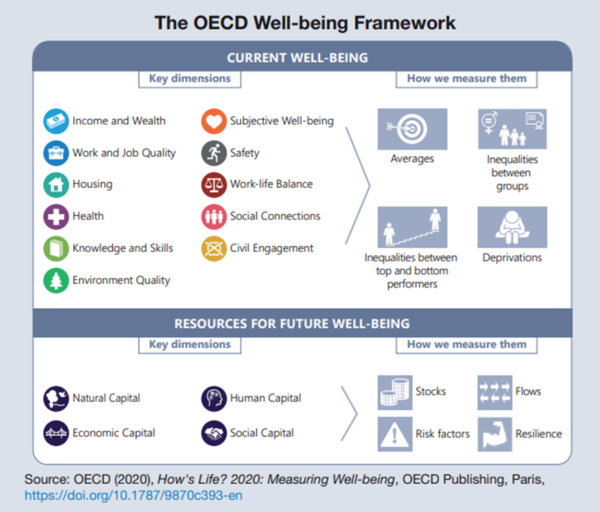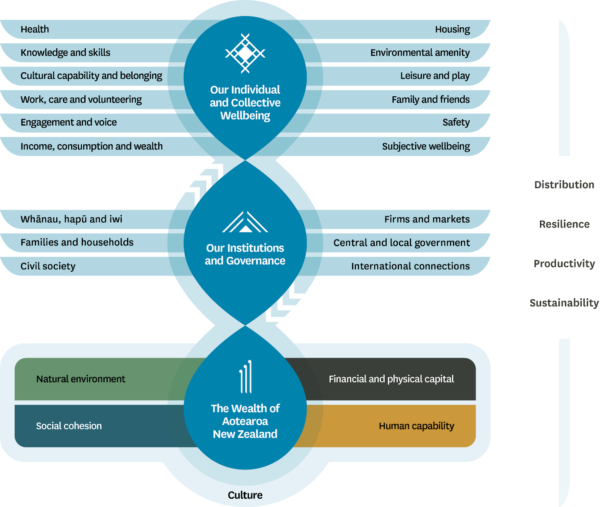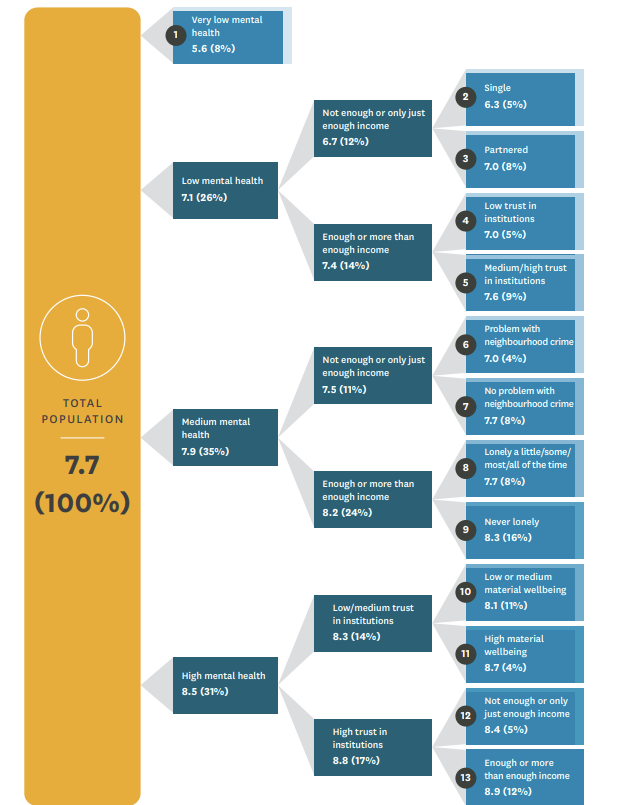New Zealand Living Standards Framework update and first wellbeing report
National Wellbeing is how we’re doing as individuals, communities and as a nation, and how sustainable that is for the future. We believe improving wellbeing is the goal of all public and civil society action, and that an evidence-informed approach based on what works should be used to inform these choices.
For the first time the New Zealand Treasury has published a Wellbeing Report, which uses the country’s updated Living Standards Framework to assess the effects of Governmental policy on quality of life. The UK equivalent of the Living Standards Framework is the Office for National Statistics Measuring National Wellbeing Programme.
Our Executive Director, Nancy Hey, outlines key updates and takes us through insights from the New Zealand report, drawing parallels with the measurement and practical use of wellbeing in policy in the UK.
–
The Living Standards Framework (Framework) 2021
Developed and refined over the last decade, New Zealand’s Living Standards Framework and accompanying dashboard of indicators are a publicly-available data bank of the trends, distribution and sustainability of the country’s wellbeing.
To make the best possible decisions for current and future generations we need relevant, high-quality and publicly available data. This is what the Framework is designed to offer. The insights support the New Zealand Treasury and other decision-makers across sectors to consider the impacts and implications of policy through a wellbeing lens using a systematic, evidenced-based approach. This functions in the same way as our six hallmarks of coherent wellbeing policy, developed to support local authority mechanisms in the UK.
New Zealand’s Living Standards Framework was originally based on the Organisation for Economic Co-operation and Development (OECD)’s framework:

Fig. 1 – OECD framework
New Zealand’s iteration includes traditional measures and proxies of societal progress, such as income and Gross Domestic Product (economic) and Life Expectancy (health), alongside broader measures important to a happy and fulfilling life. It also has measures of natural, human, social and financial capitals, which is something GDP and Life Expectancy are silent on. This helps assess the stocks, flows, risk and resilience for future wellbeing, similar to Levelling Up in the UK.
The framework was most recently updated in 2021 following public consultation. Reflecting and recognising complexities, it now incorporates children’s wellbeing and country-specific aspects of culture, including indigenous concepts, at the newly introduced Institutions and Governance level (see figure 2).
The importance of Families and Households as a fundamental building block of society is similar to the outcomes set out in the November 2021 budget in the UK.

Fig. 2 – LFS 2021
Though the Framework incorporates some of the most important concepts of these areas at a high level, it is not exhaustive. Instead, it is intend to be used alongside other in-depth frameworks such as:
- He Ara Waiora for a mātauranga Māori perspective on wellbeing;
- Fonofale for a Pacific perspective on wellbeing;
- The Children’s Commissioner’s Wellbeing Wheel for a perspective on children’s wellbeing.
This approach has been taken to avoid overloading the Framework with too much complexity and to help maintain the integrity of complementary perspectives.
You can read more about the concepts in the Framework on the New Zealand Treasury website and explore our case studies on previous iterations.
The Wellbeing Report 2022
Using the Framework and He Ara Waiora, the New Zealand Treasury has published Te Tai Waiora: Wellbeing in Aotearoa New Zealand. It assesses a wide range of aspects of life that New Zealanders value to provide a ‘big picture’ overview of the country’s wellbeing.
The report details how it has changed over time, and how well the country is positioned to sustain national wellbeing for the future, providing a long-term perspective on what the nation is doing well and what it could do better. By capturing a broad range of measures regularly and consistently using complementary frameworks, New Zealand is building a more robust evidence base to inform future decision making.
This is the first Wellbeing Report to be produced under the country’s Public Finance Act, which was amended in 2020 to specify objectives relating to social, economic, environmental and cultural wellbeing. The act requires a report to be produced at least once every four years. By legislating a way to track progress, New Zealand has shifted to a longer-term, stewardship approach, making efforts to ensure its policy making is more sustainable beyond a particular political party.
Key highlights
- The report provides a macro perspective drawing links across multiple facets of wellbeing including traditional measures of economic success alongside changes in health, social connections, life satisfaction, and the environment.
- The report uses subjective wellbeing metrics, including life satisfaction.
- Overall, the wellbeing trends show objective measures seem to be improving (safety, incomes, employment, air quality), but subjective measures such as life satisfaction worsening.
- The report provides richer insights by including information on wellbeing drivers to explain differences in life satisfaction (figure 3). Further breakdowns by demographic characteristic (seen on page 52-53 of the report) can help support better targeted policies.

Fig. 3 – mental health and incomes are important reasons behind differences in life satisfaction
Wellbeing inequalities
Despite New Zealand being rated above the OECD average for life satisfaction, ahead of countries like Australia and the UK, the report indicates significant wellbeing inequalities.
Five to 10 percent of New Zealanders experience low wellbeing across a number of indicators. Disproportionately, these are:
- Maori and pacific people;
- people with disability;
- people living in sole parent families.
The report also identifies a number of risks to future wellbeing including:
- rising rental and purchase prices in the housing market, with young more likely to be priced out or to be renting poor quality homes;
- declining education achievement
- higher levels of psychological distress among younger generation;
- climate change and biodiversity loss;
- increasing geopolitical instability.
This indicates a generational divide, with younger people faring less well on several measures.
What’s next?
New Zealand’s reporting is an iterative process and challenges still remain, including the practical application of different perspectives in policy making. By increasing our understanding of the factors that contribute to wellbeing, we can give decision makers usable insight about where to invest limited resources.
Like New Zealand, most developed countries – including the UK – are facing challenges due to unpredictable climate and economic conditions. This highlights the importance of building resilience in a way that is flexible and provides buffers against future shocks.
The ability of governments to provide vital services such as health care, education, environment and welfare are key to supporting wellbeing sustainably. This is why many, including New Zealand’s Treasury Secretary Dr Caralee McLiesh, argue for a focus on improving productivity as they believe services are dependent on economic growth. You can read more about the impact of wellbeing on productivity in our previous blog.
How to do this in the UK
The Office for National Statistics Measures of National Well-being dashboard brings together quarterly national economic, environmental, and social progress data to better support effective decision making. Publishing wellbeing data alongside economic and environmental data collates our ‘hidden wealth’ – non-monetary measures and social capital – in one place. This inclusive view enables us to measure societal progress more fully.
The UK Green Book supplementary guidance on wellbeing sets out how such multi-indicator approaches can be used in policy making and business cases. They are particularly relevant in the Strategic Case Model and in setting policy objectives.
To make wellbeing a central goal of UK policy we need to know how to do this in practice at individual, local and national levels. This is why we set out to identify and support local authority mechanisms. Discover more about our project to support Local Area wellbeing action plans. You can also explore our Wellbeing at the Heart of Policy resource for further guidance.
